Journal Description
Marine Drugs
Marine Drugs
is the leading, peer-reviewed, open access journal on the research, development, and production of biologically and therapeutically active compounds from the sea. Marine Drugs is published monthly online by MDPI. Australia New Zealand Marine Biotechnology Society (ANZMBS) is affiliated with Marine Drugs and its members receive a discount on article processing charges.
- Open Access— free for readers, with article processing charges (APC) paid by authors or their institutions.
- High Visibility: indexed within Scopus, SCIE (Web of Science), PubMed, MEDLINE, PMC, Embase, PubAg, MarinLit, AGRIS, and other databases.
- Journal Rank: JCR - Q1 (Pharmacology and Pharmacy) / CiteScore - Q1 (Pharmacology, Toxicology and Pharmaceutics (miscellaneous))
- Rapid Publication: manuscripts are peer-reviewed and a first decision is provided to authors approximately 13.7 days after submission; acceptance to publication is undertaken in 1.9 days (median values for papers published in this journal in the second half of 2024).
- Recognition of Reviewers: reviewers who provide timely, thorough peer-review reports receive vouchers entitling them to a discount on the APC of their next publication in any MDPI journal, in appreciation of the work done.
Impact Factor:
4.9 (2023);
5-Year Impact Factor:
5.2 (2023)
Latest Articles
Catechol Siderophores from a Mangrove-Derived Bacteria Serratia marcescens F2-2 and Their Cytotoxic Activity
Mar. Drugs 2025, 23(6), 241; https://doi.org/10.3390/md23060241 (registering DOI) - 30 May 2025
Abstract
Serratia marcescens is a common Gram-negative and facultative anaerobic bacillus that produces serratiochelins with several bioactivities. In this study, four catechol siderphores (1–4), including two new ones named serratiochelins E (1) and F (2), were
[...] Read more.
Serratia marcescens is a common Gram-negative and facultative anaerobic bacillus that produces serratiochelins with several bioactivities. In this study, four catechol siderphores (1–4), including two new ones named serratiochelins E (1) and F (2), were obtained from the fermentation of a mangrove-derived bacterium, S. marcescens F2-2. The structures were elucidated with various spectroscopic methods such as NMR and HR-ESI-MS. Absolute and geometric configurations of the new compounds were established by employing quantum NMR calculations in conjunction with DP4+ probability analysis, ECD calculations, and the advanced Marfey’s method. The bioactivity test showed that serratiochelin B (3) displayed weak but selective cytotoxicity against HepG2 cancer cells with an IC50 of 50.6 μmol/L and could trigger apoptosis through both Bcl-2/Bax/caspase-3 and Fas/FasL/caspase-8 signaling pathways. These findings deepen the understanding of siderophores of S. marcescens and provide a lead for research on anti-liver cancer drugs.
Full article
(This article belongs to the Special Issue Advances in Secondary Metabolites from Mangrove Holobiont)
►
Show Figures
Open AccessEditorial
Exploring Marine-Derived Antioxidant and Anti-Inflammatory Agents: Findings from Recent Studies
by
Marzia Vasarri and Donatella Degl’Innocenti
Mar. Drugs 2025, 23(6), 240; https://doi.org/10.3390/md23060240 (registering DOI) - 30 May 2025
Abstract
The Special Issue “Marine Anti-Inflammatory and Antioxidant Agents, 4th Edition” of Marine Drugs underscores the immense therapeutic potential embedded within our planet’s vast marine environments [...]
Full article
(This article belongs to the Special Issue Marine Anti-Inflammatory and Antioxidant Agents, 4th Edition)
►▼
Show Figures
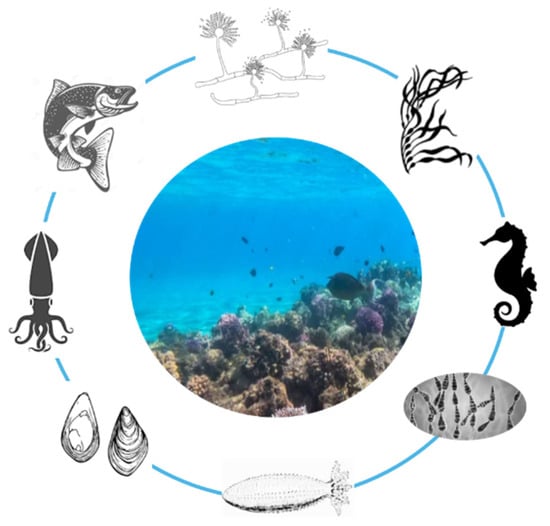
Figure 1
Open AccessArticle
Sustainable Extraction of Prospective Cosmetic Ingredients from Colombian Marine Macroalgae Using Natural Deep Eutectic Solvents
by
Verónica María Tamayo-Rincón, Jhonny Colorado-Ríos, Didier Johan Alvarez-Bustamante, Vanessa Urrea-Victoria, Diana Margarita Márquez-Fernández, Constain H. Salamanca, Stefano Dall’Acqua, Leonardo Castellanos-Hernandez and Alejandro Martínez-Martínez
Mar. Drugs 2025, 23(6), 239; https://doi.org/10.3390/md23060239 (registering DOI) - 30 May 2025
Abstract
This study presents the results obtained from extracting and quantifying cosmetically valuable metabolites such as phenolic compounds and mycosporine-like amino acids (MAAs) from 12 samples of marine macroalgae collected in the Colombian Caribbean Sea. Natural deep eutectic solvents (NADESs) were prepared, physicochemically tested
[...] Read more.
This study presents the results obtained from extracting and quantifying cosmetically valuable metabolites such as phenolic compounds and mycosporine-like amino acids (MAAs) from 12 samples of marine macroalgae collected in the Colombian Caribbean Sea. Natural deep eutectic solvents (NADESs) were prepared, physicochemically tested (viscosity, surface tension, pH, and conductivity), and then compared with water as the reference solvent to quantify phenolic compounds using the Folin–Ciocalteau test. With a simple extraction assay with water and ultrasound followed by ultraviolet spectral scanning the presence of MAAs was easily determined in several of the analysed samples, and then they were identified by HPLC-DAD. Hydrochloric acid solution at 5% extracted a higher content of phenolic compounds than NADES and water. The NADES that showed the highest phenolic compound extraction yield was a mixture of betaine, glucose, and water with 1:1:5 molar ratio. Sargassum cf. ramifolium and Sargassum fluitans showed the highest contents of phenolic compounds extracted with NADES, with 29.2 and 21.9 mg GAE/g DW, respectively. The results show that NADESs are an interesting alternative for the more efficient extraction of cosmetically valuable compounds such as phenolic compounds and mycosporine-type amino acids from marine macroalgae.
Full article
(This article belongs to the Special Issue Nutritional Content, Biologically Active Compounds, and Correlated Health Impacts of Seaweed as a Resource for Nutraceutical, Cosmetic, and Pharmaceutical Applications)
►▼
Show Figures
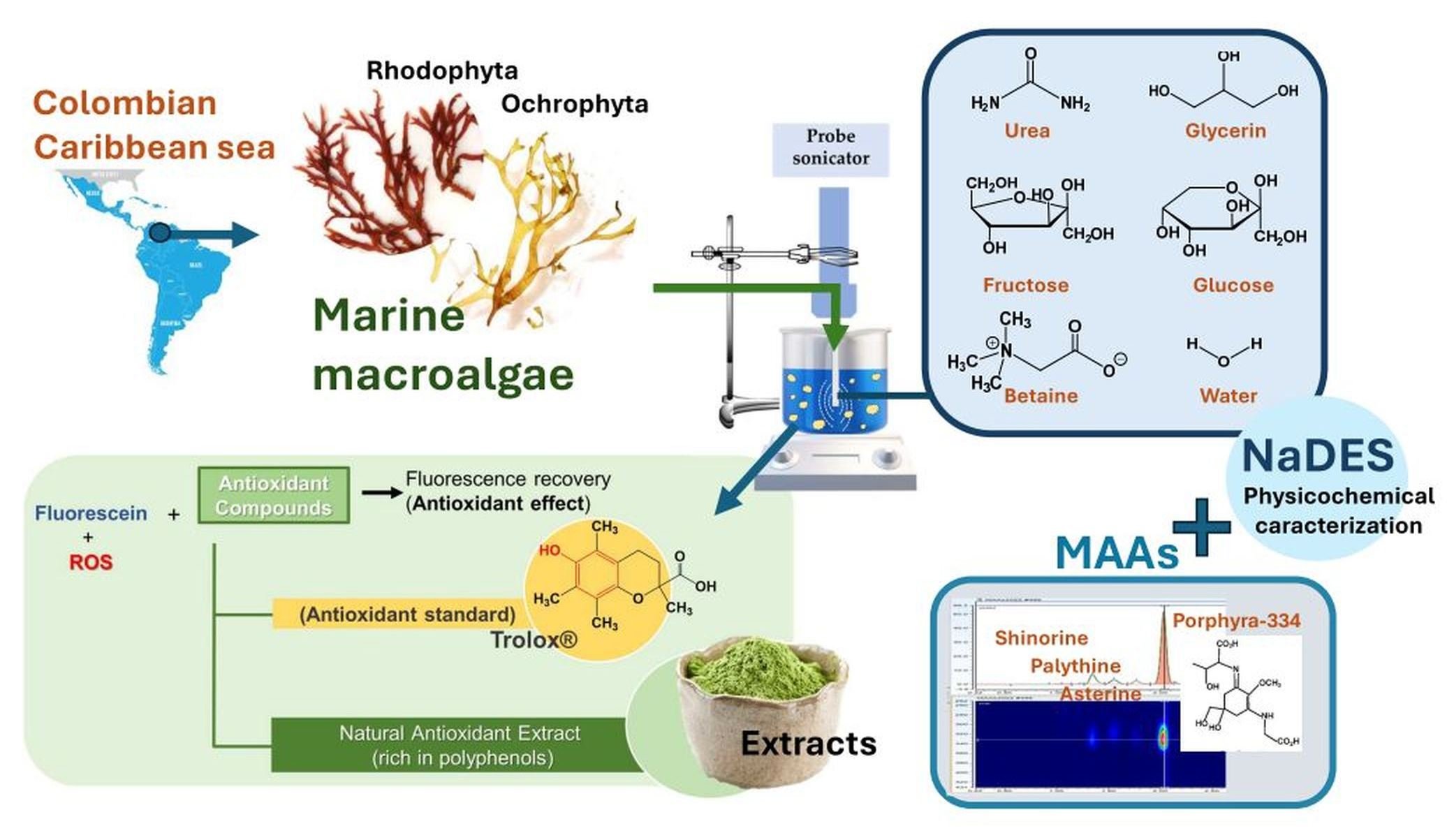
Graphical abstract
Open AccessArticle
New Bioactive Polyketides from the Mangrove-Derived Fungus Daldinia eschscholzii HJX1P2
by
Miao Yu, Yikang Qiu, Shiji Chen, Jueying Shi, Xiu Gong, Jiayi Feng, Fangru Lin, Weinv Zeng, Wenyuan Kang, Caijuan Zheng and Guolei Huang
Mar. Drugs 2025, 23(6), 238; https://doi.org/10.3390/md23060238 (registering DOI) - 30 May 2025
Abstract
Three new naphthalene–chroman dimer derivatives, daldinaphchromes A–C (1–3), two new chroman derivatives, daldichromes A (5) and B (6), along with five known compounds (4, 7–10) were isolated from the mangrove-derived
[...] Read more.
Three new naphthalene–chroman dimer derivatives, daldinaphchromes A–C (1–3), two new chroman derivatives, daldichromes A (5) and B (6), along with five known compounds (4, 7–10) were isolated from the mangrove-derived fungus Daldinia eschscholzii HJX1P2. Their structures and stereochemistries were elucidated through detailed NMR and MS analyses, calculated electronic circular dichroism, and comparison with previously reported data. Compound 1 demonstrated inhibitory effects on nitric oxide (NO) production in LPS-induced RAW 264.7 cells, with an IC50 value of 62.9 µM, and more effectively suppressed the expression of interleukin (IL)-6 than dexamethasone. A further mechanistic study suggested that 1 could prohibit the expression of iNOS in RAW 264.7 cells, and the molecular docking study suggested a possible interaction between 1 and the iNOS protein. Compounds 7 and 8 exhibited moderate to potent DPPH radical scavenging activity, with IC50 values of 117.4 and 46.2 µM, respectively, compared with the positive control ascorbic acid (IC50 = 45.6 µM). Compounds 4 and 10 showed ABTS+ radical scavenging activity, with IC50 values of 66.6 and 33.2 µM, respectively, which were equal to or lower than that of the positive control vitamin C (IC50 = 59.7 µM). Compounds 1–3, 7, and 9 showed antibacterial activity against three Staphylococcus aureus strains, with MIC values of 74.4–390.6 μM.
Full article
(This article belongs to the Special Issue Advances in Secondary Metabolites from Mangrove Holobiont)
►▼
Show Figures
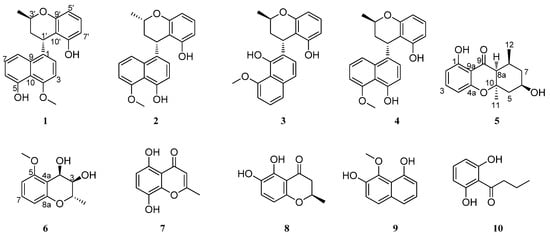
Figure 1
Open AccessCommunication
The Conopeptide αD-FrXXA, an Inhibitor of Voltage-Gated Potassium Channels
by
Luis Martínez-Hernández, Estuardo López-Vera, Ximena C. Rodriguez-Ruiz and Mónica A. Ortíz-Arellano
Mar. Drugs 2025, 23(6), 237; https://doi.org/10.3390/md23060237 - 30 May 2025
Abstract
The conopeptide αD-FrXXA was previously isolated by our team from the venom of the vermivorous snail Conus fergusoni. This toxin is composed of two chains of 47 amino acids and inhibits neuronal and muscular subtypes of nAChR. In this study, we explored
[...] Read more.
The conopeptide αD-FrXXA was previously isolated by our team from the venom of the vermivorous snail Conus fergusoni. This toxin is composed of two chains of 47 amino acids and inhibits neuronal and muscular subtypes of nAChR. In this study, we explored its effects on voltage-gated potassium channels heterologously expressed in Xenopus laevis oocytes using the two-electrode voltage-clamp technique (TEVC). At a concentration of 15 μM, αD-FrXXA was able to inhibit by 50% or more the currents of four subtypes of the Kv1 subfamily and slightly inhibit (<20%) two subtypes of the EAG subfamily. The conopeptide αD-FrXXA inhibits in a concentration-dependent manner the subtypes Kv1.3 (IC50 0.38 ± 0.06 μM) and Kv1.6 (IC50 0.52 ± 0.14 μM). The results reported here are noteworthy because this α-conopeptide behaves similarly to the α/κJ-PlXIVA conopeptide that inhibits nAChR and Kv channels.
Full article
(This article belongs to the Special Issue Conotoxins: Detection, Classification and Potential Therapeutic Benefits)
►▼
Show Figures
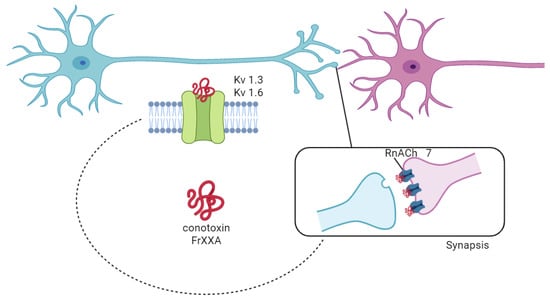
Graphical abstract
Open AccessArticle
Exploring the Inhibitory Effects of Fucosylated Chondroitin Sulfate (FCS) Oligosaccharide Isolated from Stichopus horrens and the Derivatives on P-Selectin
by
Caiyi Li, Huifang Sun, Xi Gu, Wen Long, Guangyu Zhu, Xiaolu Wu, Yu Wang, Pengfei Li, Le Sha, Jiali Zhang, Wenwu Sun, Na Gao, Zhili Zuo and Jinhua Zhao
Mar. Drugs 2025, 23(6), 236; https://doi.org/10.3390/md23060236 - 30 May 2025
Abstract
Unique fucosylated chondroitin sulfate (FCS) extracted from the sea cucumber Stichopus horrens was subjected to deacetylation and deaminative depolymerization to generate oligosaccharide fragments containing anTal-diol, which were further purified to obtain the trisaccharide ShFCS-3. Subsequently, the coupling of ShFCS-3 and 4-azidoaniline was achieved
[...] Read more.
Unique fucosylated chondroitin sulfate (FCS) extracted from the sea cucumber Stichopus horrens was subjected to deacetylation and deaminative depolymerization to generate oligosaccharide fragments containing anTal-diol, which were further purified to obtain the trisaccharide ShFCS-3. Subsequently, the coupling of ShFCS-3 and 4-azidoaniline was achieved by reductive amination. After purification, the main product ShFCS-A1 and by-product ShFCS-A2 were obtained, which were identified as (N-(L-Fuc2S4S-α1,3-D-GlcA-β1,3-D-anTalA4S6S-1-)-4-azidoaniline) and (4S)-[2-(3-L-Fuc2S4S-α1)-D-GlcA-β1]-2,4,5-trihydroxy-5-sulfated-pent-2-enoic-acid) by 1D/2D NMR spectroscopy, respectively. ELISA experiments revealed that ShFCS-A1 exhibited P-selectin inhibition rates of 19.73% ± 9.60% at 1 μM, 96.28% ± 2.37% at 10 μM, and near-complete inhibition (99.92% ± 0.84%) at 100 μM. ShFCS-A2 demonstrated inhibition rates of 8.29% ± 3.00% at 1 μM, 74.02% ± 8.80% at 10 μM, and maximal inhibition approaching 100% at 100 μM. Cellular-level experiments revealed that ShFCS-A1 and ShFCS-A2 inhibited P-selectin binding to HL-60 cells by 92.72% ± 0.85% and 96.97% ± 1.16% at 100 μM, respectively. Molecular docking analysis indicated binding energies of −5.954 kcal/mol for ShFCS-A1 and −6.140 kcal/mol for ShFCS-A2 with P-selectin, confirming their potent inhibitory effects. These findings highlight the therapeutic potential of FCS oligosaccharides as pharmacophores and provide an important foundation for developing novel small-molecule P-selectin inhibitors.
Full article
(This article belongs to the Special Issue Isolation, Identification and Applications of Marine Source Polysaccharides and Peptides—2nd Edition)
►▼
Show Figures
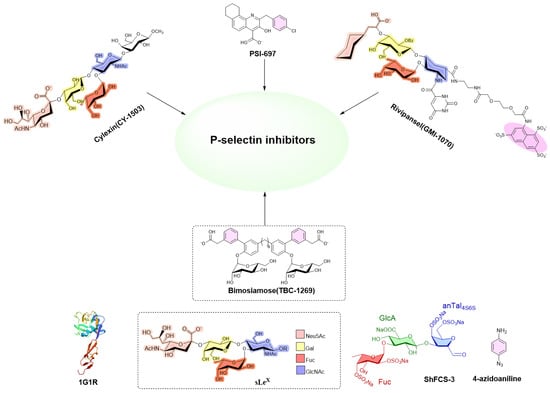
Figure 1
Open AccessReview
Marine-Derived Astaxanthin: Molecular Mechanisms, Biomedical Applications, and Roles in Stem Cell Biology
by
Aretha Rambaldi, Francesca Paris, Pasquale Marrazzo, Roberta Costa, Stefano Ratti and Francesco Alviano
Mar. Drugs 2025, 23(6), 235; https://doi.org/10.3390/md23060235 - 29 May 2025
Abstract
Astaxanthin (ASX) is a xanthophyll carotenoid mainly derived from marine microalgae such as Haematococcus pluvialis and Chlorella zofingiensis, as well as the yeast Phaffia rhodozyma. Its chemical nature structure, rich in conjugated double bonds, carbonyl, and hydroxyl groups, confers potent antioxidant
[...] Read more.
Astaxanthin (ASX) is a xanthophyll carotenoid mainly derived from marine microalgae such as Haematococcus pluvialis and Chlorella zofingiensis, as well as the yeast Phaffia rhodozyma. Its chemical nature structure, rich in conjugated double bonds, carbonyl, and hydroxyl groups, confers potent antioxidant and anti-inflammatory properties. ASX modulates oxidative stress via the PI3K/Akt-Nrf2 pathway and suppresses NF-κB-mediated inflammatory responses, reducing cytokine levels such as TNF-α, IL-6, and iNOS. ASX exerts dual apoptotic effects, cytoprotective in non-transformed cells and pro-apoptotic in cancer cells through p53 activation. Sustainable extraction techniques, especially supercritical CO2, have improved its industrial applicability. Recent findings highlight ASX’s role in stem cell biology, enhancing proliferation, supporting lineage-specific differentiation, and protecting against oxidative and inflammatory damage, which is a crucial issue for regenerative medicine applications. These multifaceted molecular effects support ASX’s therapeutic potential in chronic diseases, including diabetes, cardiovascular pathologies, and cancer. This review outlines ASX’s natural sources, extraction methods, and biological mechanisms, emphasizing its application in oxidative stress- and inflammation-related conditions.
Full article
(This article belongs to the Special Issue Recent Advances in Marine-Derived Pigments)
►▼
Show Figures

Figure 1
Open AccessArticle
Isolation and Identification of Cis-2,5-Diketopiperazine from a Novel Bacillus Strain and Synthesis of Its Four Stereoisomers
by
Alan M. C. Obled, Refaat B. Hamed, Edward Spence, Marija K. Zacharova, Sunil V. Sharma, Yunpeng Wang, Rosemary Lynch, Helen Connaris, Adina Tatheer, Marie-Lise Bourguet-Kondracki, Gordon J. Florence and Rebecca J. M. Goss
Mar. Drugs 2025, 23(6), 234; https://doi.org/10.3390/md23060234 - 29 May 2025
Abstract
The Bacillus horneckiae-like strain 2011SOCCUF3 was isolated from the marine sponge Spongia officinalis and its metabolome was studied for secondary metabolites with antimicrobial activity. Culturing in the presence of Diaion HP-20 resin and purifying the culture extract identified cyclo-phenylalanine-proline (cyclo-(Phe-Pro)), a 2,5-diketopiperazine
[...] Read more.
The Bacillus horneckiae-like strain 2011SOCCUF3 was isolated from the marine sponge Spongia officinalis and its metabolome was studied for secondary metabolites with antimicrobial activity. Culturing in the presence of Diaion HP-20 resin and purifying the culture extract identified cyclo-phenylalanine-proline (cyclo-(Phe-Pro)), a 2,5-diketopiperazine (2,5-DKP), isolated as a major metabolite. Further, LCMS analysis of the extract showed the presence of two isomers of the molecule in the culture broth. To confirm the stereochemistry of the isomers observed in the natural extract, all four stereoisomers of cyclo-(Phe-Pro) were synthesised. NMR and LCMS studies identified the presence of both cis- and trans-cyclo-(Phe-Pro) isomers. Stability and epimerisation studies on synthetic isomers and the effect of culturing conditions suggested that the less stable cis isomer was naturally produced, which epimerised in culture broth.
Full article
(This article belongs to the Section Synthesis and Medicinal Chemistry of Marine Natural Products)
►▼
Show Figures
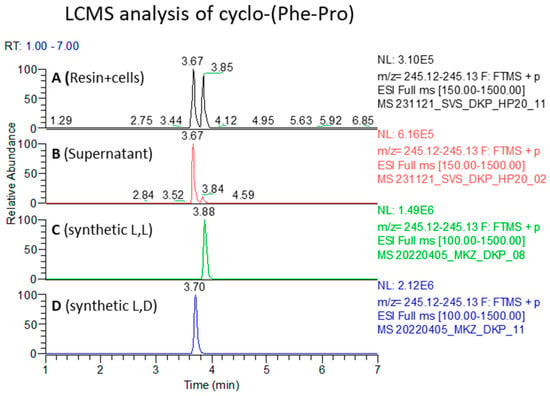
Figure 1
Open AccessFeature PaperReview
Cyanobacterial Peptides in Anticancer Therapy: A Comprehensive Review of Mechanisms, Clinical Advances, and Biotechnological Innovation
by
Heayyean Lee, Khuld Nihan and Yale Ryan Kwon
Mar. Drugs 2025, 23(6), 233; https://doi.org/10.3390/md23060233 - 29 May 2025
Abstract
Cyanobacteria-derived peptides represent a promising class of anticancer agents due to their structural diversity and potent bioactivity. They exert cytotoxic effects through mechanisms including microtubule disruption, histone deacetylase inhibition, and apoptosis induction. Several peptides—most notably the dolastatin-derived auristatins—have achieved clinical success as cytotoxic
[...] Read more.
Cyanobacteria-derived peptides represent a promising class of anticancer agents due to their structural diversity and potent bioactivity. They exert cytotoxic effects through mechanisms including microtubule disruption, histone deacetylase inhibition, and apoptosis induction. Several peptides—most notably the dolastatin-derived auristatins—have achieved clinical success as cytotoxic payloads in antibody–drug conjugates (ADCs). However, challenges such as limited tumor selectivity, systemic toxicity, and production scalability remain barriers to broader application. Recent advances in targeted delivery technologies, combination therapy strategies, synthetic biology, and genome mining offer promising solutions. Emerging data from preclinical and clinical studies highlight their therapeutic potential, particularly in treatment-resistant cancers. In this review, we (i) summarize key cyanobacterial peptides and their molecular mechanisms of action, (ii) examine progress toward clinical translation, and (iii) explore biotechnological approaches enabling sustainable production and structural diversification. We also discuss future directions for enhancing specificity and the therapeutic index to fully exploit the potential of these marine-derived peptides in oncology.
Full article
(This article belongs to the Special Issue Marine Natural Products as Anticancer Agents, 4th Edition)
►▼
Show Figures

Figure 1
Open AccessArticle
The Alkaloid Caulerpin Exhibits Potent and Selective Anti-Inflammatory Activity Through Interaction with the Glucocorticoid Receptor
by
Jônatas Sousa Pires dos Santos, Dahara Keyse Carvalho Silva, Vanessa da Silva Oliveira, Sergio Santos Silva Junior, Edivaldo dos Santos Rodrigues, Claudia Valeria Campos de Souza, Sabrina Teixeira Martinez, Osvaldo Andrade Santos-Filho, Cássio Santana Meira and Milena Botelho Pereira Soares
Mar. Drugs 2025, 23(6), 232; https://doi.org/10.3390/md23060232 - 29 May 2025
Abstract
Inflammation plays a central role in various pathological conditions, necessitating the search for safer and more effective anti-inflammatory agents. This study investigates the anti-inflammatory activity of caulerpin, a bisindolic alkaloid isolated from Caulerpa racemosa. In vitro assays demonstrated that caulerpin significantly reduced
[...] Read more.
Inflammation plays a central role in various pathological conditions, necessitating the search for safer and more effective anti-inflammatory agents. This study investigates the anti-inflammatory activity of caulerpin, a bisindolic alkaloid isolated from Caulerpa racemosa. In vitro assays demonstrated that caulerpin significantly reduced nitric oxide, TNF-α, IL-6, and IL-12 levels in macrophages stimulated with LPS + IFN-γ, without affecting cell viability. In silico toxicity predictions using Protox 3.0 reinforce a favorable safety profile of caulerpin. Molecular docking and molecular dynamics simulations revealed its high-affinity binding to the glucocorticoid receptor ligand-binding domain (GR-LBD), suggesting a mechanism of action similar to dexamethasone. The involvement of the glucocorticoid receptor was confirmed by the partial reversal of caulerpin’s effects upon RU486 treatment. In vivo, caulerpin exhibited a favorable safety profile, with no signs of acute toxicity at an oral dose of 100 mg/kg. Moreover, in a mouse model of endotoxic shock, caulerpin administration significantly improved survival rates in a dose-dependent manner, providing complete protection at 4 mg/kg. These findings highlight caulerpin as a promising candidate for the development of novel anti-inflammatory therapies. Further studies are warranted to explore its pharmacokinetics, optimize its structure, and evaluate its efficacy in chronic inflammatory diseases.
Full article
(This article belongs to the Special Issue Immunomodulatory Activities of Marine Products)
►▼
Show Figures
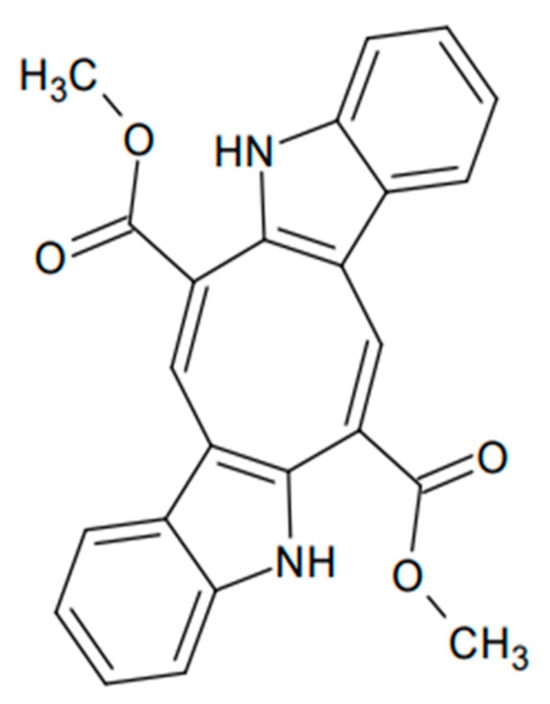
Figure 1
Open AccessReview
Advances in Jellyfish Sting Mechanisms and Treatment Strategies
by
Bingbing Li, Yueyue Li, Zhiwen Qiu, Chuantao Zhang, Yue Li, Wei Li and Jishun Yang
Mar. Drugs 2025, 23(6), 231; https://doi.org/10.3390/md23060231 - 28 May 2025
Abstract
Jellyfish stings, as one of the most prevalent forms of marine injury, have increasingly become a subject of concern. Despite their simple morphology and structure, jellyfish possess a complex venom composition that can inflict varying degrees of damage on multiple human physiological systems.
[...] Read more.
Jellyfish stings, as one of the most prevalent forms of marine injury, have increasingly become a subject of concern. Despite their simple morphology and structure, jellyfish possess a complex venom composition that can inflict varying degrees of damage on multiple human physiological systems. Consequently, the clinical symptoms associated with jellyfish stings are highly intricate. Although antivenoms have been developed for certain jellyfish species (e.g., C. fleckeri), specific antivenoms targeting the mechanisms of most jellyfish venoms remain understudied. To effectively prevent, treat, and cure jellyfish stings, we adhere to the principle of knowing their nature and their reasons. It is essential to investigate the emission mechanism of jellyfish nematocysts and the composition of their venom. Understanding these factors is crucial for the development of targeted treatment strategies. This review delves into the venom emission mechanism of jellyfish stinging cells, the symptoms resulting from jellyfish stings, and the comprehensive treatment strategies post-sting. It offers a scientific reference for comprehending jellyfish stings and establishes a theoretical foundation for subsequent research endeavors.
Full article
(This article belongs to the Section Marine Toxins)
►▼
Show Figures

Graphical abstract
Open AccessArticle
Comparative Evaluation of Dynamic Maceration and Ultrasonic Assisted Extraction of Fucoidan from Four Arctic Brown Algae on Its Antioxidant and Anticancer Properties
by
Ekaterina D. Obluchinskaya, Olga N. Pozharitskaya, Irina M. Lapina, Anna A. Kulminskaya, Elena V. Zhurishkina and Alexander N. Shikov
Mar. Drugs 2025, 23(6), 230; https://doi.org/10.3390/md23060230 - 28 May 2025
Abstract
The technology of fucoidan extraction significantly affects its properties. This study aimed to evaluate the impact of dynamic maceration (DM) and ultrasound-assisted extraction (UAE) on the antioxidant and anticancer properties of fucoidan from Arctic brown algae. Fucus vesiculosus (Fv), Fucus serratus (Fs), Fucus
[...] Read more.
The technology of fucoidan extraction significantly affects its properties. This study aimed to evaluate the impact of dynamic maceration (DM) and ultrasound-assisted extraction (UAE) on the antioxidant and anticancer properties of fucoidan from Arctic brown algae. Fucus vesiculosus (Fv), Fucus serratus (Fs), Fucus distichus (Fd), and Ascophyllum nodosum (An) were collected from the Barents Sea. The average yield of fucoidan and uronic acid was higher (by 43.2% and 22.0%, respectively) after UAE, while phlorotannin content decreased by 53.7% compared with DM. The fucose level for all algae increased after UAE, while the molecular weight of fucoidans was lower. The highest antioxidant activity was noted for the fucoidan from An and Fv, which were obtained by DM and can be associated with the high concentrations of phlorotannins. The treatment of HeLa G-63 cells with all studied fucoidans for 48 h increased concentration-dependently the number of dead cells. The most promising were Fv and Fs fucoidans with high phlorotannins, low sulfates, and uronic acid extracted by DM. The co-administration of paclitaxel and fucoidan caused cell cycle arrest in the G2/M phase. The calculated for the first time combinatory effect showed that the simultaneous use of paclitaxel and fucoidan exposure leads to a synergistic interaction. Our results support the rationality of fucoidan use in complex chemotherapy to improve survival, quality of life and immunity in patients with cervical carcinoma.
Full article
(This article belongs to the Special Issue The Extraction and Application of Functional Components in Algae)
►▼
Show Figures

Figure 1
Open AccessReview
Chemical Defenses in Medusozoa
by
Oliver J. Lincoln, Jonathan D. R. Houghton, Muhammad Zakariya, Chiara Lauritano and Isabella D’Ambra
Mar. Drugs 2025, 23(6), 229; https://doi.org/10.3390/md23060229 - 28 May 2025
Abstract
Cnidarian defensive strategies are commonly associated with the toxins they synthesize. Because toxins have negative, sometimes lethal, effects on humans, research has focused on them for medical and biotechnological applications. However, Cnidaria possess a variety of defensive systems complementing toxins. In recent decades,
[...] Read more.
Cnidarian defensive strategies are commonly associated with the toxins they synthesize. Because toxins have negative, sometimes lethal, effects on humans, research has focused on them for medical and biotechnological applications. However, Cnidaria possess a variety of defensive systems complementing toxins. In recent decades, ecological and biotechnological studies have shed light on these systems, particularly in Anthozoa, while the knowledge of defensive systems different from toxins has remained limited in Medusozoa (Cubozoa, Hydrozoa, Scyphozoa and Staurozoa). In this review, we collected the scattered information available in the literature and organized it into four main topics: UV-light protection compounds, antioxidants, antimicrobial peptides, and endosymbionts. Within the topics, we found the largest amount of data refers to antimicrobial activities, which suggests this line of research as a potential exploitation of this group of organisms often appearing in large aggregates. We also found that some Medusozoa have been studied in detail as model organisms, although the close phylogenetic relationship among classes suggests that some defensive strategies may be common to other members of different classes. Indeed, an integrated understanding of defensive systems has the potential to inform not only ecological and evolutionary frameworks, but also biotechnological applications—from the identification of novel antioxidants or antimicrobial agents to the valorization of Medusozoan biomass.
Full article
(This article belongs to the Section Marine Chemoecology for Drug Discovery)
►▼
Show Figures

Graphical abstract
Open AccessArticle
Chondroitin Sulfate as a Lysosomal Enhancer Attenuates Lipid-Driven Inflammation via Lipophagy and Mitophagy
by
Ting Sun, Huimin Lv, Huarong Shao, Xiuhua Zhang, Anqi Wang, Wei Zhang, Fei Liu and Peixue Ling
Mar. Drugs 2025, 23(6), 228; https://doi.org/10.3390/md23060228 - 27 May 2025
Abstract
Non-alcoholic steatohepatitis (NASH), a progressive liver disease characterized by lipid accumulation and chronic inflammation, lacks effective therapies targeting its multifactorial pathogenesis. This study investigates marine-derived chondroitin sulfate (CS) as a multi-organelle modulator capable of regulating lipid metabolism, oxidative stress, and inflammation in NASH.
[...] Read more.
Non-alcoholic steatohepatitis (NASH), a progressive liver disease characterized by lipid accumulation and chronic inflammation, lacks effective therapies targeting its multifactorial pathogenesis. This study investigates marine-derived chondroitin sulfate (CS) as a multi-organelle modulator capable of regulating lipid metabolism, oxidative stress, and inflammation in NASH. By employing subcellular imaging and organelle-specific labeling techniques, we demonstrate that CS restores lysosomal acidification in a NASH model, enabling the reduction of lipid droplets via lysosomal–lipid droplet fusion. Concurrently, CS upregulates dynamin-related protein 1 (DRP1), driving mitochondrial terminal fission to spatially isolate reactive oxygen species (ROS) segments for mitophagy, thereby reducing ROS levels. Notably, pharmacological inhibition of lysosomal activity using chloroquine or bafilomycin A1 abolished the therapeutic effects of CS, confirming lysosomal acidification as an essential prerequisite. Collectively, these findings reveal the potential of CS as a therapeutic agent for NASH and provide critical insights into the subcellular mechanisms underlying its protective effects, thus offering a foundation for future research and therapeutic development.
Full article
(This article belongs to the Section Marine Pharmacology)
►▼
Show Figures
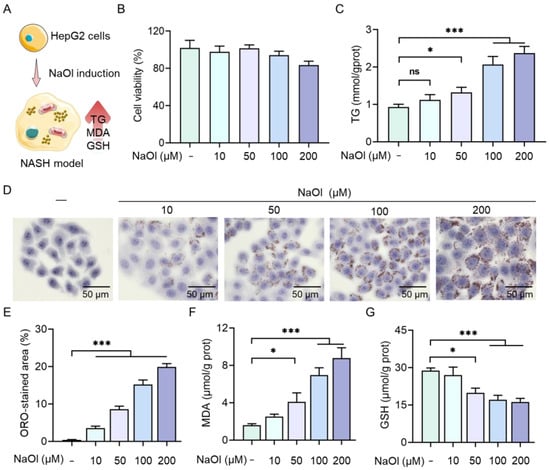
Figure 1
Open AccessReview
Harnessing Thalassochemicals: Marine Saponins as Bioactive Agents in Nutraceuticals and Food Technologies
by
Vicente Domínguez-Arca, Thomas Hellweg and Luis T. Antelo
Mar. Drugs 2025, 23(6), 227; https://doi.org/10.3390/md23060227 - 26 May 2025
Abstract
The expanding field of nutraceuticals and functional food science is increasingly turning to marine-derived bioactive compounds, particularly saponins, for their diverse pharmacological properties. These so-called thalassochemicals display distinctive structural features—such as sulfated glycosidic moieties and amphiphilic backbones—that underpin potent antitumor, hypolipidemic, antioxidant, and
[...] Read more.
The expanding field of nutraceuticals and functional food science is increasingly turning to marine-derived bioactive compounds, particularly saponins, for their diverse pharmacological properties. These so-called thalassochemicals display distinctive structural features—such as sulfated glycosidic moieties and amphiphilic backbones—that underpin potent antitumor, hypolipidemic, antioxidant, and antimicrobial activities. In contrast to their terrestrial analogs, marine saponins remain underexplored, and their complexity poses analytical and functional challenges. This review provides a critical and integrative synthesis of recent advances in the structural elucidation, biological function, and technological application of marine saponins. Special emphasis is placed on the unresolved limitations in their isolation, characterization, and structural validation, including coelution of isomers, adduct formation in MS spectra, and lack of orthogonal techniques such as NMR or FTIR. We illustrate these limitations through original MS/MS data and propose experimental workflows to improve compound purity and identification fidelity. In addition to discussing known structure–activity relationships (SARs) and mechanisms of action, we extend the scope by integrating recent developments in computational modeling, including machine learning, molecular descriptors, and quantitative structure–activity relationship (QSAR) models. These tools offer new avenues for predicting saponin bioactivity, despite current limitations in available high-quality datasets. Furthermore, we include a classification and comparison of steroidal and triterpenoid saponins from marine versus terrestrial sources, complemented by detailed chemical schematics. We also address the impact of processing techniques, delivery systems, and bioavailability enhancements using encapsulation and nanocarriers. Finally, this review contextualizes these findings within the regulatory and sustainability frameworks that shape the future of saponin commercialization. By bridging analytical chemistry, computational biology, and food technology, this work establishes a roadmap for the targeted development of marine saponins as next-generation nutraceuticals and functional food ingredients.
Full article
(This article belongs to the Special Issue Marine Nutraceuticals and Functional Foods: 2nd Edition)
►▼
Show Figures
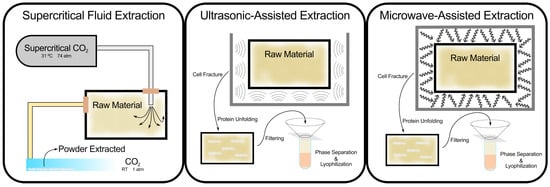
Figure 1
Open AccessArticle
Potential of Marine Bacterial Metalloprotease A69 in the Preparation of Antarctic Krill Peptides with Multi-Bioactivities
by
Rui Liu, Wen-Jie Cao, Wen-Xiao Zhao, Xiao-Jie Yuan, Yu-Zhong Zhang, Qi-Long Qin, Xiao-Yan Song, Xi-Ying Zhang, Jian Li, Xiu-Lan Chen and Yu-Qiang Zhang
Mar. Drugs 2025, 23(6), 226; https://doi.org/10.3390/md23060226 - 24 May 2025
Abstract
Antarctic krill (Euphausia superba) is a nutrient-rich marine resource. Although several terrestrial proteases have been used to prepare Antarctic krill peptides (AKPs), there has been no report on the preparation of AKPs using a marine protease. Here, marine bacterial protease A69
[...] Read more.
Antarctic krill (Euphausia superba) is a nutrient-rich marine resource. Although several terrestrial proteases have been used to prepare Antarctic krill peptides (AKPs), there has been no report on the preparation of AKPs using a marine protease. Here, marine bacterial protease A69 was used to prepare AKPs with multi-bioactivities. Through optimizing hydrolysis parameters, we established a process for AKPs preparation by hydrolyzing Antarctic krill powder with A69. In the prepared AKPs, peptides less than 3000 Da and 1000 Da accounted for 99.23% and 88.37%, respectively. The scavenging ratios of the AKPs to ABTS+, DPPH· and ·OH reached 93.23 ± 0.09%, 99.90 ± 0.15%, and 93.90 ± 0.47%, respectively. The AKPs also had high angiotensin-converting enzyme (ACE)-inhibitory activity, with an IC50 of 0.22 ± 0.04 mg/mL. At 40 mg/mL, the AKPs inhibited α-glucosidase and dipeptidyl peptidase IV (DPP-IV) activities by 7.18% and 13.62%, respectively, and displayed antibacterial activity to Escherichia coli. Moreover, 14 antioxidant peptides, 24 ACE-inhibitory peptides, 2 α-glucosidase-inhibitory peptides, and 10 DPP-Ⅳ-inhibitory peptides were identified from the AKPs. These results demonstrate that the prepared AKPs contain diverse bioactive peptides and have multi-bioactivities. This study indicates that marine bacterial protease A69 has promising application potential in preparing AKPs with multi-bioactivities.
Full article
(This article belongs to the Special Issue Marine Proteins and Enzymes: Bioactivities and Medicinal Applications)
►▼
Show Figures

Figure 1
Open AccessArticle
Aphanizomenon flos-aquae: A Biorefinery for Health and Energy—Unleashing Phycocyanin’s Power and Biogas Potential
by
Pilar Águila-Carricondo, Raquel García-García, Juan Pablo de la Roche, Pedro Luis Galán, Luis Fernando Bautista, Juan J. Espada and Gemma Vicente
Mar. Drugs 2025, 23(6), 225; https://doi.org/10.3390/md23060225 - 24 May 2025
Abstract
This study presents a biorefinery approach for Aphanizomenon flos-aquae, demonstrating its potential as a dual source for phycocyanin and biogas. The antioxidant capacity of the extract was evaluated using the ABTS•+ assay, while flow cytometry determined its cytotoxic effects on breast
[...] Read more.
This study presents a biorefinery approach for Aphanizomenon flos-aquae, demonstrating its potential as a dual source for phycocyanin and biogas. The antioxidant capacity of the extract was evaluated using the ABTS•+ assay, while flow cytometry determined its cytotoxic effects on breast cancer (HCC1806) and brain glioma (U-118 MG) cell lines, comparing pure C-phycocyanin to the non-purified extract. The non-purified extract scavenged 77% of ABTS•+ radicals at 2.4 mg/mL, compared to 22% for pure C-phycocyanin. In U-118 MG cells, pure C-phycocyanin accounted for 55.5% of the 29.9 ± 6.1% total mortality observed with the non-purified extract at 0.75 mg/mL. HCC1806 cytotoxicity (80.9 ± 5.1% at 1 mg/mL) was attributed to synergistic effects of other extract components. The spent biomass was valorized through anaerobic digestion for biogas production, enhancing process sustainability. At a 2:1 inoculum-to-substrate ratio, the anaerobic digestion of the spent biomass yielded 447 ± 18 mL CH4/gVS, significantly higher than the 351 ± 19 mL CH4/gVS from the initial biomass. LCA estimated the environmental impacts of the A. flos-aquae biorefinery for phycocyanin production, targeting the cosmetic, food, and nutraceutical sectors, and highlighting the benefits of spent biomass valorization to produce biogas within a circular economy framework. This integrated approach demonstrates the potential of A. flos-aquae for the sustainable production of high-value compounds and renewable energy.
Full article
(This article belongs to the Special Issue Algae-Powered Skincare: Innovations in Marine-Derived Cosmeceuticals)
►▼
Show Figures
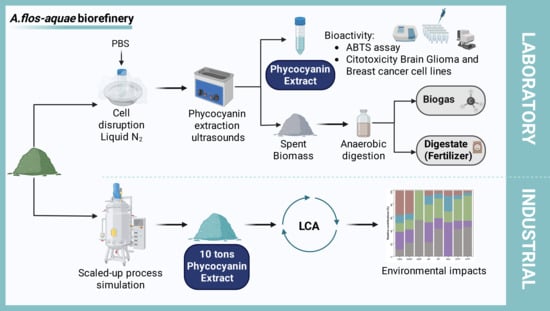
Graphical abstract
Open AccessArticle
Exploration of Bioactive Compounds, Antioxidant and Antibacterial Properties, and Their Potential Efficacy Against HT29 Cell Lines in Dictyota bartayresiana
by
Durairaj Swarna Bharathi, Andiyappan Boopathy Raja, Suganthi Nachimuthu, S. Thangavel, Karthik Kannan, Sengottaiyan Shanmugan and Vinaya Tari
Mar. Drugs 2025, 23(6), 224; https://doi.org/10.3390/md23060224 - 23 May 2025
Abstract
This study investigates the rare seaweed alga Dictyota bartayresiana lamour for biological activity. Antioxidant and antibacterial activities were examined. An MTT assay was carried out to examine cytotoxicity activity against colon cancer cells. The HPTLC analysis was performed for four different extracts, which
[...] Read more.
This study investigates the rare seaweed alga Dictyota bartayresiana lamour for biological activity. Antioxidant and antibacterial activities were examined. An MTT assay was carried out to examine cytotoxicity activity against colon cancer cells. The HPTLC analysis was performed for four different extracts, which exhibited clear flavonoid band formation at 254 nm and 366 nm with varied ranges of Rf values: methanolic extract (Rf 0.87), acetone extract (Rf 0.82), and benzene (Rf 0.83). Methanolic Extract Fraction One (MEF1) has a distinct band formation at 366 nm, it is shown to have the highest inhibition (6.20 ± 0.53 mm) against Escherichia coli, and the MTT assay reveals that the aqueous extract of Dictyota bartayresiana extract has an IC50 value of 300 µg/mL. It is divulged that methanolic extract shows the highest phytochemical compound level among the four extracts of Dictyota bartayresiana. A GC/MS analysis was employed to investigate the flavonoid profile of the crude seaweed extract. Although LC/MS is typically preferred for flavonoid analysis due to thermal sensitivity, GC/MS was used in this study owing to time constraints, with optimized conditions to reduce thermal degradation. The GC-MS analysis identified Quinoline and other flavonoids, suggesting potential bioactivity. The cytotoxicity activity of MEF1 shows that the development of a promising drug may be evaluated from a seaweed source. The present study provides excellent insight with the first report of the biologically active compound of Dictyota bartayresiana.
Full article
(This article belongs to the Special Issue Marine Algae: Exploring Their Nutritional, Health, and Nutraceutical Potential)
►▼
Show Figures
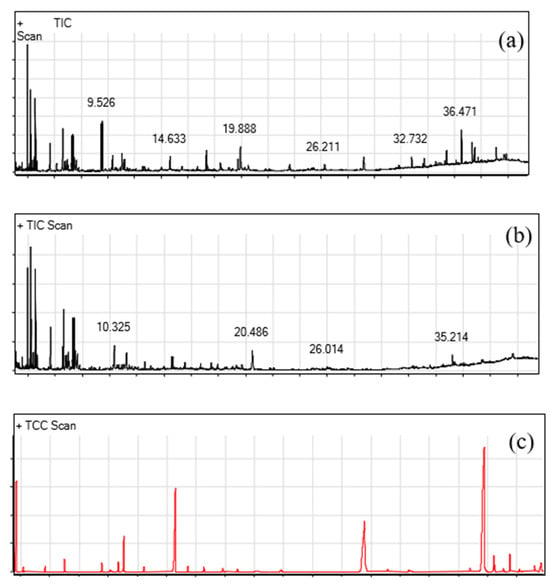
Figure 1
Open AccessReview
Marine-Derived Antioxidants: A Comprehensive Review of Their Therapeutic Potential in Oxidative Stress-Associated Diseases
by
Ruiqiu Zhang, Yuke Ren, Tianqi Ren, Yue Yu, Bo Li and Xiaobing Zhou
Mar. Drugs 2025, 23(6), 223; https://doi.org/10.3390/md23060223 - 22 May 2025
Abstract
Oxidative stress is a critical factor contributing to the pathogenesis of numerous diseases, including cardiovascular disorders, diabetes, and neurodegenerative conditions. In recent years, marine-derived antioxidants have emerged as promising therapeutic agents due to their unique biological activities and diverse sources. This comprehensive review
[...] Read more.
Oxidative stress is a critical factor contributing to the pathogenesis of numerous diseases, including cardiovascular disorders, diabetes, and neurodegenerative conditions. In recent years, marine-derived antioxidants have emerged as promising therapeutic agents due to their unique biological activities and diverse sources. This comprehensive review explores the therapeutic potential of various marine antioxidants in mitigating oxidative stress-associated diseases. Marine organisms are rich in bioactive compounds, such as polysaccharides, polyphenols, carotenoids, peptides, and vitamins, which exhibit potent antioxidant and free radical scavenging abilities. These compounds have been shown to effectively inhibit oxidative reactions, repair oxidative damage, and enhance the body’s antioxidant defense mechanisms. For instance, marine polysaccharides and their derivatives can scavenge reactive oxygen species (ROS), protect neurons from oxidative damage, and alleviate inflammation in neurodegenerative diseases like Alzheimer’s and Parkinson’s diseases. Similarly, marine unsaturated fatty acids, such as omega-3 polyunsaturated fatty acids (PUFAs), have been found to reduce cardiovascular risks by lowering serum triglyceride levels and improving vascular endothelial function. Additionally, marine-derived superoxide dismutase (SOD) plays a crucial role in neutralizing ROS, thereby offering protection against oxidative stress in various diseases. Despite these promising findings, challenges remain in the field, including the need for improved extraction and purification technologies, more comprehensive activity evaluation systems, and further research into the safety and bioavailability of these compounds. This review provides a detailed overview of the current research status, highlighting the types, structural characteristics, antioxidant activities, and mechanisms of action of marine antioxidants. It also identifies key areas for future research and development, aiming to harness the full potential of marine-derived antioxidants in the prevention and treatment of oxidative stress-related diseases.
Full article
(This article belongs to the Special Issue Marine Anti-inflammatory Agents )
►▼
Show Figures

Figure 1
Open AccessReview
Diversity of Bioactive Compounds in Microalgae: Key Classes and Functional Applications
by
Maslin Osathanunkul, Suebsuya Thanaporn, Lefkothea Karapetsi, Georgia Maria Nteve, Emmanouil Pratsinakis, Eleni Stefanidou, Giorgos Lagiotis, Eleni Avramidou, Lydia Zorxzobokou, Georgia Tsintzou, Artemis Athanasiou, Sofia Mpelai, Constantinos Constandinidis, Panagiota Pantiora, Marián Merino, José Luis Mullor, Luka Dobrovic, Leonardo Cerasino, Tomohisa Ogawa, Meropi Tsaousi, Alexandre M. C. Rodrigues, Helena Cardoso, Rita Pires, Daniel Figueiredo, Inês F. Costa, Catarina Anjos, Nikolaos E. Labrou and Panagiotis Madesisadd
Show full author list
remove
Hide full author list
Mar. Drugs 2025, 23(6), 222; https://doi.org/10.3390/md23060222 - 22 May 2025
Abstract
Microalgae offer a sustainable and versatile source of bioactive compounds. Their rapid growth, efficient CO2 utilization, and adaptability make them a promising alternative to traditional production methods. Key compounds, such as proteins, polyunsaturated fatty acids (PUFAs), polyphenols, phytosterols, pigments, and mycosporine-like amino
[...] Read more.
Microalgae offer a sustainable and versatile source of bioactive compounds. Their rapid growth, efficient CO2 utilization, and adaptability make them a promising alternative to traditional production methods. Key compounds, such as proteins, polyunsaturated fatty acids (PUFAs), polyphenols, phytosterols, pigments, and mycosporine-like amino acids (MAAs), hold significant commercial value and are widely utilized in food, nutraceuticals, cosmetics, and pharmaceuticals, driving innovation across multiple industries. Their antiviral and enzyme-producing capabilities further enhance industrial and medical applications. Additionally, microalgae-based biostimulants and plant elicitor peptides (PEPs) contribute to sustainable agriculture by enhancing plant growth and resilience to environmental stressors. The GRAS status of several species facilitates market integration, but challenges in scaling and cost reduction remain. Advances in biotechnology and metabolic engineering will optimize production, driving growth in the global microalgae industry. With increasing consumer demand for natural, eco-friendly products, microalgae will play a vital role in health, food security, and environmental sustainability.
Full article
(This article belongs to the Special Issue Marine Biorefinery for Bioactive Compounds Production)
►▼
Show Figures

Figure 1

Journal Menu
► ▼ Journal Menu-
- Marine Drugs Home
- Aims & Scope
- Editorial Board
- Reviewer Board
- Instructions for Authors
- Special Issues
- Topics
- Sections & Collections
- Article Processing Charge
- Indexing & Archiving
- Editor’s Choice Articles
- Most Cited & Viewed
- Journal Statistics
- Journal History
- Journal Awards
- Society Collaborations
- Conferences
- Editorial Office
Journal Browser
► ▼ Journal Browser-
arrow_forward_ios
Forthcoming issue
arrow_forward_ios Current issue - Vol. 23 (2025)
- Vol. 22 (2024)
- Vol. 21 (2023)
- Vol. 20 (2022)
- Vol. 19 (2021)
- Vol. 18 (2020)
- Vol. 17 (2019)
- Vol. 16 (2018)
- Vol. 15 (2017)
- Vol. 14 (2016)
- Vol. 13 (2015)
- Vol. 12 (2014)
- Vol. 11 (2013)
- Vol. 10 (2012)
- Vol. 9 (2011)
- Vol. 8 (2010)
- Vol. 7 (2009)
- Vol. 6 (2008)
- Vol. 5 (2007)
- Vol. 4 (2006)
- Vol. 3 (2005)
- Vol. 2 (2004)
- Vol. 1 (2003)
Highly Accessed Articles
Latest Books
E-Mail Alert
News
Topics
Topic in
Biomolecules, IJMS, Molecules, Sci. Pharm., Marine Drugs, Plants
Antioxidant Activity of Natural Products—2nd Edition
Topic Editors: José Virgílio Santulhão Pinela, Maria Inês Moreira Figueiredo Dias, Carla Susana Correia Pereira, Alexandra PlácidoDeadline: 30 September 2025
Topic in
Agrochemicals, Agronomy, Insects, IJMS, Marine Drugs, Toxins, Agriculture, Biology
Research on Natural Bioactive Product-Based Pesticidal Agents—2nd Edition
Topic Editors: Min Lv, Hui XuDeadline: 28 February 2026
Topic in
Applied Biosciences, Applied Sciences, Fermentation, Marine Drugs, Microorganisms, Phycology
Microalgae: Current Trends in Basic Research and Applications
Topic Editors: Nhuan Nghiem, Tae Hyun KimDeadline: 31 March 2026
Topic in
Applied Biosciences, Applied Microbiology, Fermentation, Marine Drugs, Microorganisms
Microbial Cell Factories for Natural Products
Topic Editors: Carlos Barreiro, Ana Ibáñez, José L. BarredoDeadline: 31 May 2026

Conferences
Special Issues
Special Issue in
Marine Drugs
Application of Marine Nature Products to Reduce Oxidative Stress
Guest Editor: Chieh-Hsi WuDeadline: 31 May 2025
Special Issue in
Marine Drugs
Advances of Marine-Derived Enzymes
Guest Editor: Olafur FridjonssonDeadline: 31 May 2025
Special Issue in
Marine Drugs
Marine Natural Products for Neglected Tropical Diseases
Guest Editors: Andre G. Tempone, João Henrique Ghilardi LagoDeadline: 31 May 2025
Topical Collections
Topical Collection in
Marine Drugs
Marine Compounds and Cancer
Collection Editors: Friedemann Honecker, Sergey A. Dyshlovoy
Topical Collection in
Marine Drugs
Microalgal Active Biomolecules
Collection Editor: Cédric Delattre
Topical Collection in
Marine Drugs
Papers from “Sino–Italian Symposium on Bioactive Natural Products”
Collection Editors: Orazio Taglialatela-Scafati, Hong Wang











